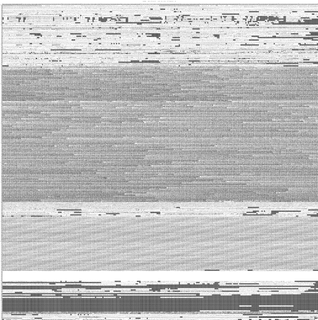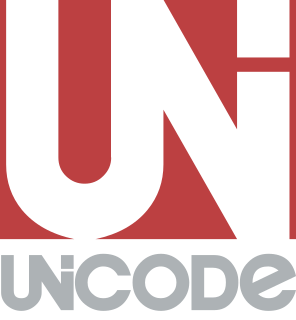Character encoding is used to represent a repertoire of characters by some kind of encoding system. Depending on the abstraction level and context, corresponding code points and the resulting code space may be regarded as bit patterns, octets, natural numbers, electrical pulses, etc. A character encoding is used in computation, data storage, and transmission of textual data. "Character set", "character map", "codeset" and "code page" are related, but not identical, terms.
HTML has been in use since 1991, but HTML 4.0 was the first standardized version where international characters were given reasonably complete treatment. When an HTML document includes special characters outside the range of seven-bit ASCII, two goals are worth considering: the information's integrity, and universal browser display.
Extended Binary Coded Decimal Interchange Code is an eight-bit character encoding used mainly on IBM mainframe and IBM midrange computer operating systems. It descended from the code used with punched cards and the corresponding six bit binary-coded decimal code used with most of IBM's computer peripherals of the late 1950s and early 1960s. It is supported by various non-IBM platforms, such as Fujitsu-Siemens' BS2000/OSD, OS-IV, MSP, and MSP-EX, the SDS Sigma series, Unisys VS/9, Burroughs MCP and ICL VME.
ISO/IEC 8859 is a joint ISO and IEC series of standards for 8-bit character encodings. The series of standards consists of numbered parts, such as ISO/IEC 8859-1, ISO/IEC 8859-2, etc. There are 15 parts, excluding the abandoned ISO/IEC 8859-12. The ISO working group maintaining this series of standards has been disbanded.

UTF-16 is a character encoding capable of encoding all 1,112,064 valid code points of Unicode. The encoding is variable-length, as code points are encoded with one or two 16-bit code units.
In telecommunication, an End-of-Transmission character (EOT) is a transmission control character. Its intended use is to indicate the conclusion of a transmission that may have included one or more texts and any associated message headings.
The byte order mark (BOM) is a Unicode character, U+FEFFBYTE ORDER MARK (BOM), whose appearance as a magic number at the start of a text stream can signal several things to a program reading the text:
UTF-32 stands for Unicode Transformation Format in 32 bits. It is a protocol to encode Unicode code points that uses exactly 32 bits per Unicode code point (but a number of leading bits must be zero as there are fewer than 221 Unicode code points). UTF-32 is a fixed-length encoding, in contrast to all other Unicode transformation formats, which are variable-length encodings. Each 32-bit value in UTF-32 represents one Unicode code point and is exactly equal to that code point's numerical value.
UTF-7 is a variable-length character encoding that was proposed for representing Unicode text using a stream of ASCII characters. It was originally intended to provide a means of encoding Unicode text for use in Internet E-mail messages that was more efficient than the combination of UTF-8 with quoted-printable.
A double-byte character set (DBCS) is a character encoding in which either all characters are encoded in two bytes, or merely every graphic character not representable by an accompanying single-byte character set (SBCS) is encoded in two bytes. A DBCS supports national languages that contain a large number of unique characters or symbols. Examples of such languages include Japanese and Chinese. Korean Hangul does not contain as many characters, but KS X 1001 supports both Hangul and Hanja, and uses two bytes per character.

GB 18030 is a Chinese government standard, described as Information Technology — Chinese coded character set and defines the required language and character support necessary for software in China. GB18030 is the registered Internet name for the official character set of the People's Republic of China (PRC) superseding GB2312. As a Unicode Transformation Format, GB18030 supports both simplified and traditional Chinese characters. It is also compatible with legacy encodings including GB2312, CP936, and GBK 1.0.
Binary Ordered Compression for Unicode (BOCU) is a MIME compatible Unicode compression scheme. BOCU-1 combines the wide applicability of UTF-8 with the compactness of Standard Compression Scheme for Unicode (SCSU). This Unicode encoding is designed to be useful for compressing short strings, and maintains code point order. BOCU-1 is specified in a Unicode Technical Note.
The C0 and C1 control code or control character sets define control codes for use in text by computer systems that use the ISO/IEC 2022 system of specifying control and graphic characters. Most character encodings, in addition to representing printable characters, also have characters such as these that represent additional information about the text, such as the position of a cursor, an instruction to start a new line, or a message that the text has been received.
This article compares Unicode encodings. Two situations are considered: 8-bit-clean environments, and environments that forbid use of byte values that have the high bit set. Originally such prohibitions were to allow for links that used only seven data bits, but they remain in the standards and so software must generate messages that comply with the restrictions. Standard Compression Scheme for Unicode and Binary Ordered Compression for Unicode are excluded from the comparison tables because it is difficult to simply quantify their size.
Specials is a short Unicode block allocated at the very end of the Basic Multilingual Plane, at U+FFF0–FFFF. Of these 16 code points, five are assigned as of Unicode 12.0:
The Universal Coded Character Set (UCS) is a standard set of characters defined by the International Standard ISO/IEC 10646, Information technology — Universal Coded Character Set (UCS), which is the basis of many character encodings. The latest version contains over 136,000 abstract characters, each identified by an unambiguous name and an integer number called its code point. This ISO/IEC 10646 standard is maintained in conjunction with The Unicode Standard ("Unicode"), and they are code-for-code identical.
KS X 1001, formerly called KS C 5601, is a South Korean coded character set standard to represent hangul and hanja characters on a computer.
Microsoft was one of the first companies to implement Unicode in their products, while they are still in 2018 improving their operating system support for UTF-8. Windows NT was the first operating system that used "wide characters" in system calls. Using the UCS-2 encoding scheme at first, it was upgraded to UTF-16 starting with Windows 2000, allowing a representation of additional planes with surrogate pairs.



